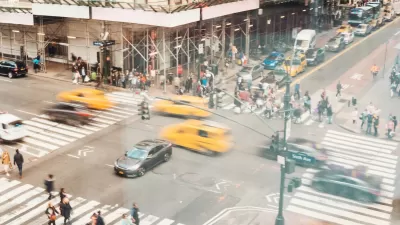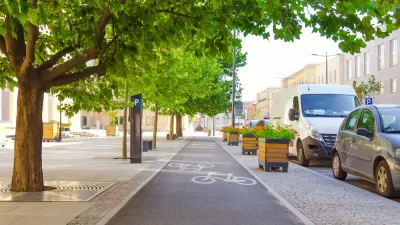Data from New York City show that traffic safety projects that give pedestrians the most space are the most effective in reducing fatal crashes and injuries.

“New data published by the New York City Department of Transportation adds to a growing body of evidence about which interventions most effectively reduce traffic deaths and serious injuries.” In an article for Governing, Jared Brey describes the projects that had the biggest effect on street safety.
“The data show substantial reductions in serious injuries and fatalities for all roadway users resulting from street improvement projects like road diets, pedestrian islands, curb and sidewalk extensions, and leading pedestrian intervals — all on the order of 30 percent or more.” Brey adds that turn calming and protected bike lanes also had an impact of 15 percent of more.
The study, originally undertaken to analyze the effect of interventions on senior citizens, was broadened to include all road users. Brey notes that “Injury data specifically for cyclists were not included in the study, though a separate 2021 report looked at the impact of street interventions on risks for bikers.”
According to the study, projects that give pedestrians more space show the best results. “Another important takeaway was that conventional bike lanes, which involve little more than paint, did result in significantly fewer deaths and serious injuries.” While protected bike lanes help more, all designated bike lanes seem to have some effect on reducing dangerous crashes.
According to Beth Osborne, director of Transportation for America and vice president of transportation and thriving communities for Smart Growth America, New York City should serve as a model for planning, implementing, and then studying the results of traffic calming projects. “The tragedy is NYC DOT is a standout. We almost never check on what state DOTs or city DOTs promise.”
FULL STORY: What Are the Best Safe-Streets Improvements?

Maui's Vacation Rental Debate Turns Ugly
Verbal attacks, misinformation campaigns and fistfights plague a high-stakes debate to convert thousands of vacation rentals into long-term housing.

Planetizen Federal Action Tracker
A weekly monitor of how Trump’s orders and actions are impacting planners and planning in America.

San Francisco Suspends Traffic Calming Amidst Record Deaths
Citing “a challenging fiscal landscape,” the city will cease the program on the heels of 42 traffic deaths, including 24 pedestrians.

Detroit Says Problems With Property Tax Assessments are Fixed. Advocates Disagree.
With higher-valued properties under assessed and lower-valued properties over assessed, advocates say there's still a problem with Detroit's property tax system.

Defunct Pittsburgh Power Plant to Become Residential Tower
A decommissioned steam heat plant will be redeveloped into almost 100 affordable housing units.

Trump Prompts Restructuring of Transportation Research Board in “Unprecedented Overreach”
The TRB has eliminated more than half of its committees including those focused on climate, equity, and cities.
Urban Design for Planners 1: Software Tools
This six-course series explores essential urban design concepts using open source software and equips planners with the tools they need to participate fully in the urban design process.
Planning for Universal Design
Learn the tools for implementing Universal Design in planning regulations.
Heyer Gruel & Associates PA
JM Goldson LLC
Custer County Colorado
City of Camden Redevelopment Agency
City of Astoria
Transportation Research & Education Center (TREC) at Portland State University
Jefferson Parish Government
Camden Redevelopment Agency
City of Claremont





























